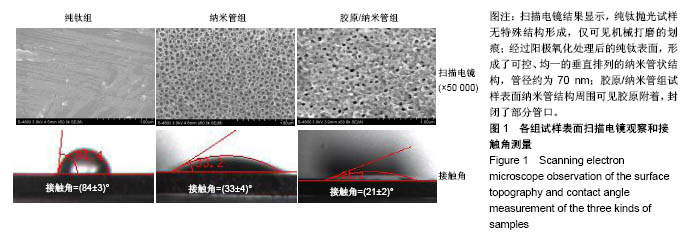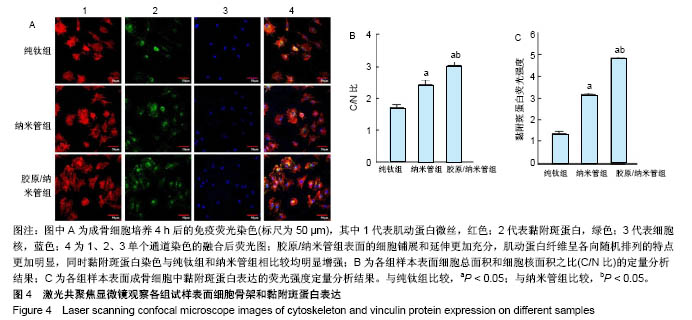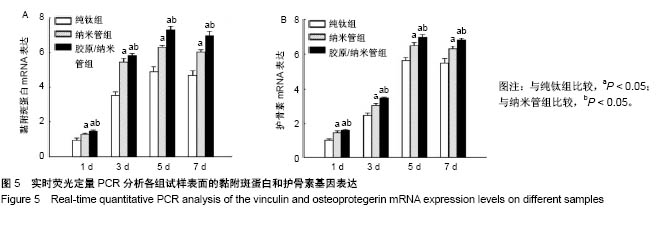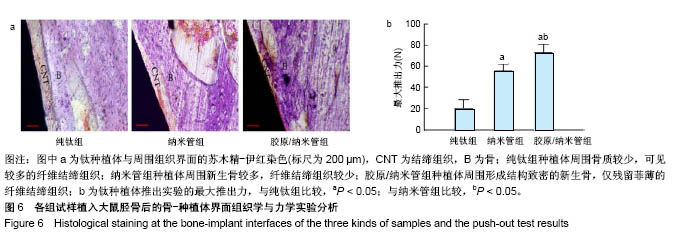| [1] Bagno A,Di Bello C. Surface treatments and roughness properties of ti-based biomaterials. J Mater Sci Mater Med. 2004;15(9):935-949.[2] Shi Q,Qian Z,Liu D,et al.Surface modification of dental titanium implant by layer-by-layer electrostatic self-assembly. Front Physiol.2017;8:574.[3] Decuzzi P,Ferrari M.Modulating cellular adhesion through nanotopography. Biomaterials. 2010;31(1):173-179.[4] Meswania IM,Bousdras VA,Ahir SP,et al. A novel closed-loop electromechanical stimulator to enhance osseointegration with immediate loading of dental implant restorations. Proc Inst Mech Eng H. 2010;224(10):1221-1232.[5] 李莺,李长义.钛种植体表面改性策略及对骨整合的影响[J].中国组织工程研究,2013,17(29):5395-5402.[6] Mendonca G,Mendonca DB,Aragao FJ,et al. Advancing dental implant surface technology--from micron- to nanotopography. Biomaterials. 2008;29(28):3822-3835.[7] Li B,Li Y,Li J,et al.Influence of nanostructures on the biological properties of ti implants after anodic oxidation.J Mater Sci Mater Med.2014;25(1):199-205.[8] Minagar S,Wang J,Berndt CC,et al.Cell response of anodized nanotubes on titanium and titanium alloys. J Biomed Mater Res A.2013;101(9):2726-2739.[9] Li Y,Li B,Fu X,et al.Anodic oxidation modification improve bioactivity and biocompatibility of titanium implant surface.J Hard Tissue Biol.2013;22(3):351-358.[10] Avila G,Misch K,Galindo-Moreno P,et al. Implant surface treatment using biomimetic agents. Implant Dent. 2009;18(1): 17-26.[11] 川叶,马敏先,张弢,等.Ⅰ型胶原修饰纯钛片促进人脂肪间充质干细胞增殖[J].中国组织工程研究, 2014,18(25):4032-4037.[12] Ricard-Blum S,Ruggiero F.The collagen superfamily: From the extracellular matrix to the cell membrane. Pathol Biol (Paris).2005;53(7):430-442.[13] 李赛娜,康跻耀,高建萍,等.胶原涂层对3d 打印种植体表面生物相容性的影响[J].中国组织工程研究, 2017,21(10):1558-1564.[14] Morra M,Cassinelli C,Meda L,et al. Surface analysis and effects on interfacial bone microhardness of collagen-coated titanium implants: A rabbit model. Int J Oral Maxillofac Implants. 2005;20(1):23-30.[15] Sartori M,Giavaresi G,Parrilli A,et al. Collagen type i coating stimulates bone regeneration and osteointegration of titanium implants in the osteopenic rat.Int Orthop. 2015;39(10): 2041-2052.[16] Liu P,Hao Y,Zhao Y,et al.Surface modification of titanium substrates for enhanced osteogenetic and antibacterial properties. Colloids Surf B Biointerfaces.2017;160:110-116.[17] Tang H,Li Y,Ma J,et al.Improvement of biological and mechanical properties of titanium surface by anodic oxidation. Biomed Mater Eng.2016;27(5):485-494.[18] Song Y,Ma A,Ning J,et al. Loading icariin on titanium surfaces by phase-transited lysozyme priming and layer-by-layer self-assembly of hyaluronic acid/chitosan to improve surface osteogenesis ability. Int J Nanomedicine.2018;13 6751-6767.[19] Geissler U,Hempel U,Wolf C,et al.Collagen type i-coating of ti6al4v promotes adhesion of osteoblasts. J Biomed Mater Res.2000;51(4):752-760.[20] Roehlecke C,Witt M,Kasper M,et al. Synergistic effect of titanium alloy and collagen type i on cell adhesion, proliferation and differentiation of osteoblast-like cells. Cells Tissues Organs. 2001;168(3):178-187.[21] Caiazza S,Colangelo P,Bedini R,et al.Evaluation of guided bone regeneration in rabbit femur using collagen membranes. Implant Dent. 2000;9(3):219-225.[22] Itoh S,Kikuchi M,Takakuda K,et al.The biocompatibility and osteoconductive activity of a novel hydroxyapatite/collagen composite biomaterial, and its function as a carrier of rhbmp-2. J Biomed Mater Res. 2001;54(3):445-453.[23] Andres JL,DeFalcis D,Noda M,et al.Binding of two growth factor families to separate domains of the proteoglycan betaglycan. J Biol Chem. 1992;267(9):5927-5930.[24] Brighton CT,Albelda SM.Identification of integrin cell-substratum adhesion receptors on cultured rat bone cells. J Orthop Res.1992;10(6):766-773.[25] Ruoslahti E,Pierschbacher MD.New perspectives in cell adhesion: Rgd and integrins. Science. 1987;238(4826): 491-497.[26] Salasznyk RM,Williams WA,Boskey A,et al. Adhesion to vitronectin and collagen i promotes osteogenic differentiation of human mesenchymal stem cells. J Biomed Biotechnol. 2004;2004(1):24-34.[27] Rammelt S,Schulze E,Bernhardt R,et al. Coating of titanium implants with type-i collagen. J Orthop Res. 2004;22(5): 1025-1034.[28] Rammelt S,Schulze E,Witt M,et al. Collagen type i increases bone remodelling around hydroxyapatite implants in the rat tibia. Cells Tissues Organs. 2004;178(3):146-157.[29] Mathews S,Bhonde R,Gupta PK,et al. A novel tripolymer coating demonstrating the synergistic effect of chitosan, collagen type 1 and hyaluronic acid on osteogenic differentiation of human bone marrow derived mesenchymal stem cells. Biochem Biophys Res Commun. 2011;414(1): 270-276.[30] Chen S,Guo Y,Liu R,et al. Tuning surface properties of bone biomaterials to manipulate osteoblastic cell adhesion and the signaling pathways for the enhancement of early osseointegration. Colloids Surf B Biointerfaces. 2018;164: 58-69.[31] Bays JL,DeMali KA.Vinculin in cell-cell and cell-matrix adhesions.Cell Mol Life Sci. 2017;74(16):2999-3009.[32] Zhao J,Watanabe T,Bhawal UK,et al.Transcriptome analysis of beta-tcp implanted in dog mandible. Bone. 2011;48(4): 864-877.[33] Zhan X,Zhang C,Dissanayaka WL,et al.Storage media enhance osteoclastogenic potential of human periodontal ligament cells via rankl-independent signaling. Dent Traumatol.2013;29(1):59-65.[34] Sul YT.Electrochemical growth behavior, surface properties, and enhanced in vivo bone response of tio2 nanotubes on microstructured surfaces of blasted, screw-shaped titanium implants. Int J Nanomedicine.2010;5:87-100.[35] von Wilmowsky C,Bauer S,Roedl S,et al. The diameter of anodic tio2 nanotubes affects bone formation and correlates with the bone morphogenetic protein-2 expression in vivo.Clin Oral Implants Res. 2012;23(3):359-366.[36] Popat KC,Leoni L,Grimes CA,et al.Influence of engineered titania nanotubular surfaces on bone cells. Biomaterials. 2007; 28(21):3188-3197. |
.jpg)






.jpg)
.jpg)